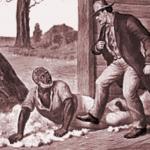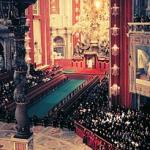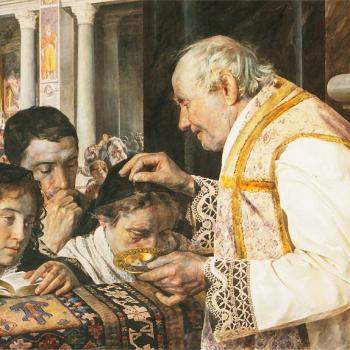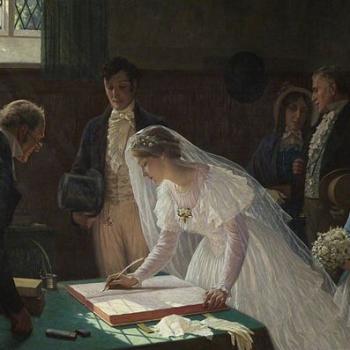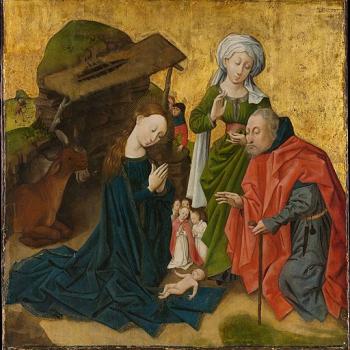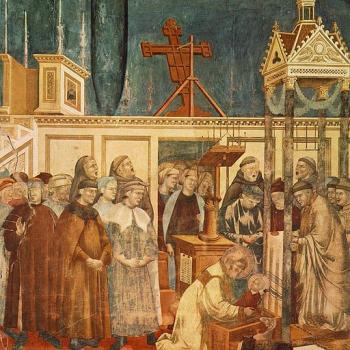In this post I continue my ruminations on Catholic social teaching, based on a reading group I am leading on the Papal social encyclicals. Previously, I have blogged about Rerum Novarum, Quadragesimo Anno, Mater et Magistra, and Pacem in Terris. This month we shifted gears slightly and are reading Gaudium et Spes, the Pastoral Constitution on the Church in the Modern World, one of the most important documents of the Second Vatican Council. It was the last document written and it was approved on the last day of the Council, December 7, 1965. It’s opening line is one of the most quoted of any document from Vatican II:
The joys and the hopes, the griefs and the anxieties of the men of this age, especially those who are poor or in any way afflicted, these are the joys and hopes, the griefs and anxieties of the followers of Christ. (par. 1)
For our first discussion, we read the Introduction and then the first chapter of Part I (par. 1-22). This document has a much more complex internal structure than any of the encyclicals we have read. It consists of a lengthy introduction and then two parts, each of which is subdivided into several chapters. Note that since each of the numbered “paragraphs” often consists of several actual paragraphs, to help with references I will enumerate the paragraphs as “a”, “b”, etc. Since I cannot refer to the author by name, I will refer to it as “the constitution” or by the initials GS.
The text itself is much more sophisticated than those of the encyclicals we had read up to this point. This seems to be a function of several things. First, this document is trying to lay a philosophical and theological foundation, rather than building on a given set of Church teachings which it implicitly assumes. Second, unlike the previous documents, which were the work of the Pope and one or two close advisors, this constitution was written by a committee, and every single word was scrutinized by the bishops before being approved. This led to a much more nuanced text. Moreover, the people reading it were not just the bishops but also the periti, the theological advisors that many bishops brought, and which included some of the greatest theologians of the mid-twentieth century: Joseph Ratzinger, John Courtney Murray, Yves Congar, Karl Rahner. They brought to the document (indeed, to all the documents of Vatican II) a very rich theological perspective.
Our discussion immediately turned to the paragraphs on atheism (par. 19-21), which we felt were among the most intriguing in the text. As one member of the group put it, the constitution “nails it.” Another member of our group pointed out that one peritus, Henri de Lubac, had written a 500 page book about atheism, and it is not unreasonable to assume that he must have played an important role in drafting this section.
Rather than condemning atheism as a monolithic, homogeneous belief system, GS unpacks the concept and notes the many different kinds of beliefs that fall into this broad category:
- those who “expressly deny” the existence of God;
- those who claim we can know nothing about God, if God exists;
- those who believe science explains everything;
- those who deny the existence of absolute truth;
- those who laud man so much that they forget God;
- those who do not think questions about God and religion are worth the trouble.
Rather than setting up straw men to demolish, the text considers each of these different strands fairly. Militant atheism (those with views at or close to the top of the list) are the bete noire of many conservative Catholics, but it seems to me that they are few in number. The so-called New Atheists, led by Hitchens, Dawkins, Harris and Dennett, were all the vogue in the 1990s and early 2000s, but soon revealed just how shallow and ungrounded their arguments really were. David Bentley Hart did a marvelous job of skewering their intellectual pretensions; I also want to give a shout out to my former colleague Borden Painter‘s takedown of their abuse of history.
In our discussions we were more interested in those whose views are towards the end of the list, who comprise the new category emerging in survey data: the rise of the “nones“. While this is a relatively new category in American discussions of religion, they idea is much older. As the text writes in its analysis of the 1960s:
On the other hand, growing numbers of people are abandoning religion in practice. Unlike former days, the denial of God or of religion, or the abandonment of them, are no longer unusual and individual occurrences. (par. 7b, emphasis added)
On member of our group is very involved in evangelization and with outreach to people in this group. He called our attention to the way in which the GS acknowledges the role that Christians and Christianity have played in creating modern atheism and the “nones”:
For, taken as a whole, atheism is not a spontaneous development but stems from a variety of causes, including a critical reaction against religious beliefs, and in some places against the Christian religion in particular. Hence believers can have more than a little to do with the birth of atheism. To the extent that they neglect their own training in the faith, or teach erroneous doctrine, or are deficient in their religious, moral or social life, they must be said to conceal rather than reveal the authentic face of God and religion. (par. 19c)
This led us on something of a tangent, which is the question of what constitutes effective evangelization: how do we as a Church overcome the barriers to faith that we have sometimes helped to construct? The paradox is that while those who do not “see why they should trouble themselves about religion” (par. 19b) have no interest in explicit discussions about metaphysics, they are nevertheless, troubled by deep existential questions:
Though mankind is stricken with wonder at its own discoveries and its power, it often raises anxious questions about the current trend of the world, about the place and role of man in the universe, about the meaning of its individual and collective strivings, and about the ultimate destiny of reality and of humanity. (par. 3a)
So the question becomes: how do we meet people where they are, speak to what troubles them, and make the truth that the Church offers relevant to their lives? For the rest of the discussion we bounced around in the text we had read, but we were always coming back to this question. This section concludes with the observation that it is the lived faith of Catholics that can do this:
The remedy which must be applied to atheism, however, is to be sought in a proper presentation of the Church’s teaching as well as in the integral life of the Church and her members….This faith needs to prove its fruitfulness by penetrating the believer’s entire life, including its worldly dimensions, and by activating him toward justice and love, especially regarding the needy. (par. 21e)
This idea of a lived faith has echoed through the papal social encyclicals; I think in particular of the pastoral section at the end of QA. The idea of a lived faith requires a deeper understanding of the times in which it is lived–our faith is grounded on universal truths, but an ahistorical approach to them had left the Church badly prepared to respond to a changing world. (See my criticisms of Leo XIII and Rerum Novarum.) Part of the evolution of the Catholic social teaching has been the ever increasing willingness to grapple with historical realities and changing circumstances, a point of view that began to come to fruition in the encyclicals of John XXIII. In GS, the Council Fathers continued along this path, and in fact assert that
[t]o carry out such a task, the Church has always had the duty of scrutinizing the signs of the times and of interpreting them in the light of the Gospel. Thus, in language intelligible to each generation, she can respond to the perennial questions which men ask about this present life and the life to come, and about the relationship of the one to the other. (par. 4a)
Unfortunately, it seems that many times, the Church is behind the curve in understanding and responding to the new world with the Gospel. There are always prophets and voices, however, since the Holy Spirit speaks in every age. And the Church always responds to them, though sometimes quickly and sometimes slowly. The goal of speaking “in language intelligible to each generation” is a complicated one. To speak in universal, ahistorical truths preserves the truth of Christ, but often obscures its meaning at a moment when it needs to be heard. On the other hand, the quest to be understood always risks sliding into relevance, and mistaking the voice of this age for the voice of the Lord. I do not think that this happens as often as conservatives are wont to charge, but it has happened before, and it will happen again. This is, however, a risk that the Church must take. As John XXIII said when he opened the Second Vatican Council:
The substance of the ancient doctrine of the deposit of faith is one thing, and the way in which it is presented is another. And it is the latter that must be taken into great consideration with patience if necessary, everything being measured in the forms and proportions of a magisterium which is predominantly pastoral in character.
The pastoral character of this truth means that it must be presented in a way in which it can be accepted, one which resonates with the deepest longings of the human person. This entails a conversation between the Church, the holder of truth, and the conscience of the individual. The conscience should be open and receptive to the truth of Christ, since
Conscience is the most secret core and sanctuary of a man. There he is alone with God, Whose voice echoes in his depths. In a wonderful manner conscience reveals that law which is fulfilled by love of God and neighbor. In fidelity to conscience, Christians are joined with the rest of men in the search for truth… (par. 16a)
This led us to the question of what to do when someone’s conscience is misled or misinformed. How to show the truth to someone who is confirmed in error is a difficult task, and correction must be done carefully. The more interesting question is what to do when the person’s conscience is correct contrary to what the Church (superficially) teaches, but is true to the Gospel? Great reforming saints and sinners have grappled with this question, more or less successfully, through the ages: St. Francis of Assisi, St. Ignatius of Loyola, Dorothy Day, St. Oscar Romero at times seemed to put themselves in opposition to the Church, but were vindicated in the end. And even Martin Luther did not start out to reject the Gospel but to correct error and abuse.
In some sense, the call of Vatican II was for the Church to be “like the head of a household who brings from his storeroom both the new and the old.” (Mt 13:52) The Church should not hoard the truth, like a miser with his gold, but unpack them and share them with the faithful and with the world. But even after the Council the Church has done a mediocre job with religious formation. We prepare our children for the sacraments, but then leave them with an 8th grade understanding of their faith. Other church communities do a much better job of adult religious formation. Indeed, in contrast I am reminded of an old socialist ideal, that a liberal education (history, philosophy, literature) should be made widely available to the working class. In the 1930’s Lancelot Hogben wrote a textbook, Mathematics for the Million, which was intended to take the reader from elementary arithmetic through calculus. It was not a popularization (in the sense of “gee-whiz” pop science) but a real attempt to make real mathematics accessible to a broad audience. If this can be done for secular ends, we should also be doing it for greater ends of the Church: “For the children of this world are more prudent in dealing with their own generation than are the children of light.” (Lk 16:8)
One problem may be that Catholics, historically, through years of training through neo-Scholastic manual tradition ( perhaps best exemplified by the Baltimore Catechism) which had a tendency to reduce questions of faith and morals to a series of propositions had developed a superficial view of the faith that boiled it down to black and white answers. The Second Vatican Council eschewed this approach and called on the faithful to acquire a broad and flexible faith which would allow them to “scrutinize the signs of the times”. This would lead to the formation of adult consciences that were in conformity to the truth and able to speak effectively to the world. This, however, is neither easy nor comforting–radical freedom (especially freedom in Christ) is always frightening, and too many people want the false comfort of black and white answers. This is obviously a problem with conservatives, but it also affects liberals as well. (In this regard, see my long ago post on Traversing the Christian Fantasy, an attempt to apply the ideas of Slavoj Zizek to the Catholicism.)
The question then becomes how to form such consciences. In the end, we are all called to put on the mind of Christ, so we can
carry forward the work of Christ under the lead of the befriending Spirit. And Christ entered this world to give witness to the truth, to rescue and not to sit in judgment, to serve and not to be served. (par. 3b)
We are called to listen to and discern the voice of the Spirit, which speaks through the Church, but also speaks where God wills. As the constitution makes clear:
All this holds true not only for Christians, but for all men of good will in whose hearts grace works in an unseen way. For, since Christ died for all men, and since the ultimate vocation of man is in fact one, and divine, we ought to believe that the Holy Spirit in a manner known only to God offers to every man the possibility of being associated with this paschal mystery. (par. 22e)
And if all men and women are associated with the mystery of Christ, then they can become vehicles for speaking this truth even to Catholics. This is not to suggest that we should turn away from the truth which the Church holds and teaches, but rather that we should be open to finding it in all people, even atheists and “nones” and using this as a springboard for dialog and evangelization.
Cover Image: Second Vatican Council by Lothar Wolleh, used with permission, from Wikimedia Commons.


